Change Management Summary Assesment
VerifiedAdded on 2022/08/20
|12
|3642
|16
AI Summary
Contribute Materials
Your contribution can guide someone’s learning journey. Share your
documents today.
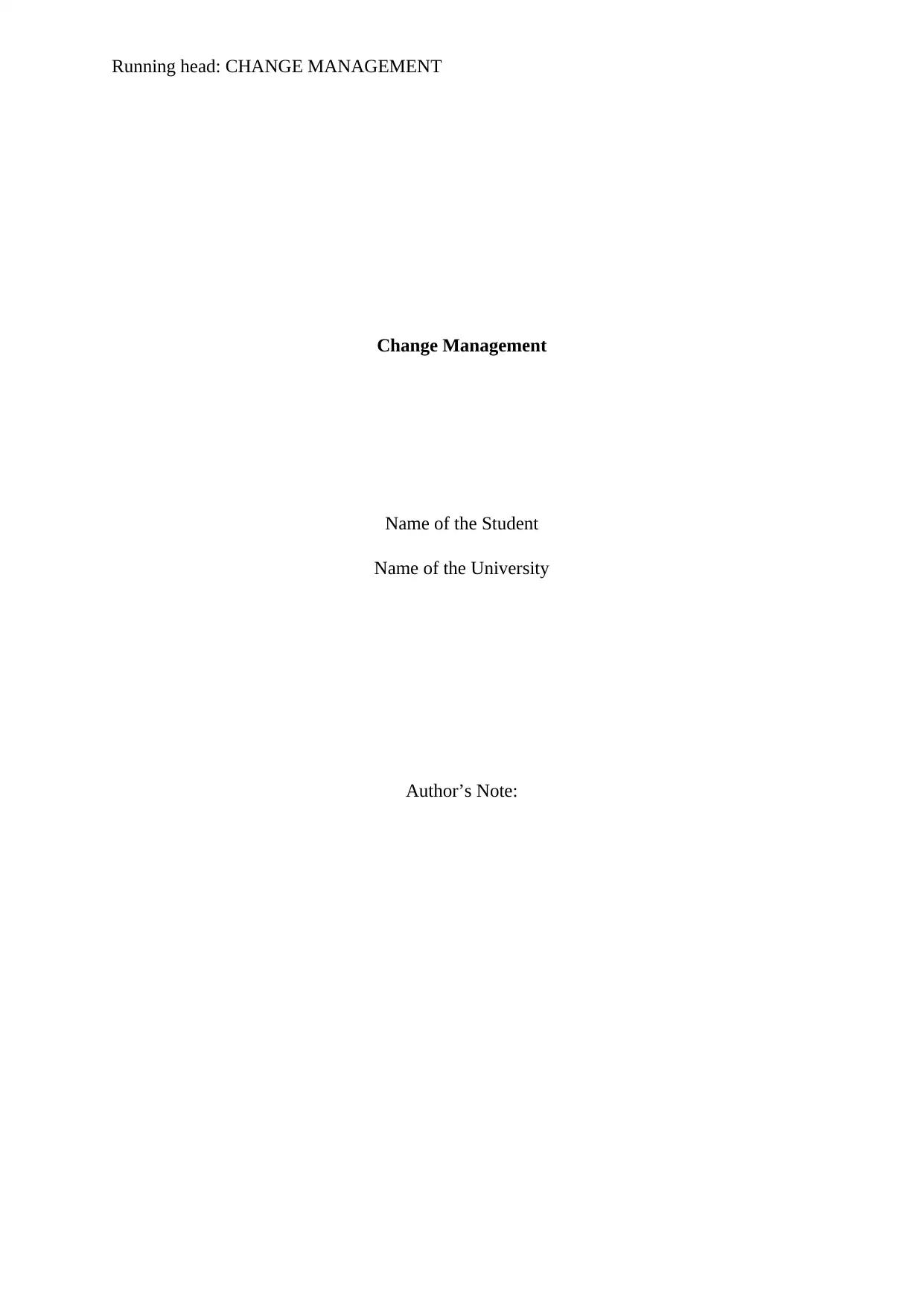
Running head: CHANGE MANAGEMENT
Change Management
Name of the Student
Name of the University
Author’s Note:
Change Management
Name of the Student
Name of the University
Author’s Note:
Secure Best Marks with AI Grader
Need help grading? Try our AI Grader for instant feedback on your assignments.
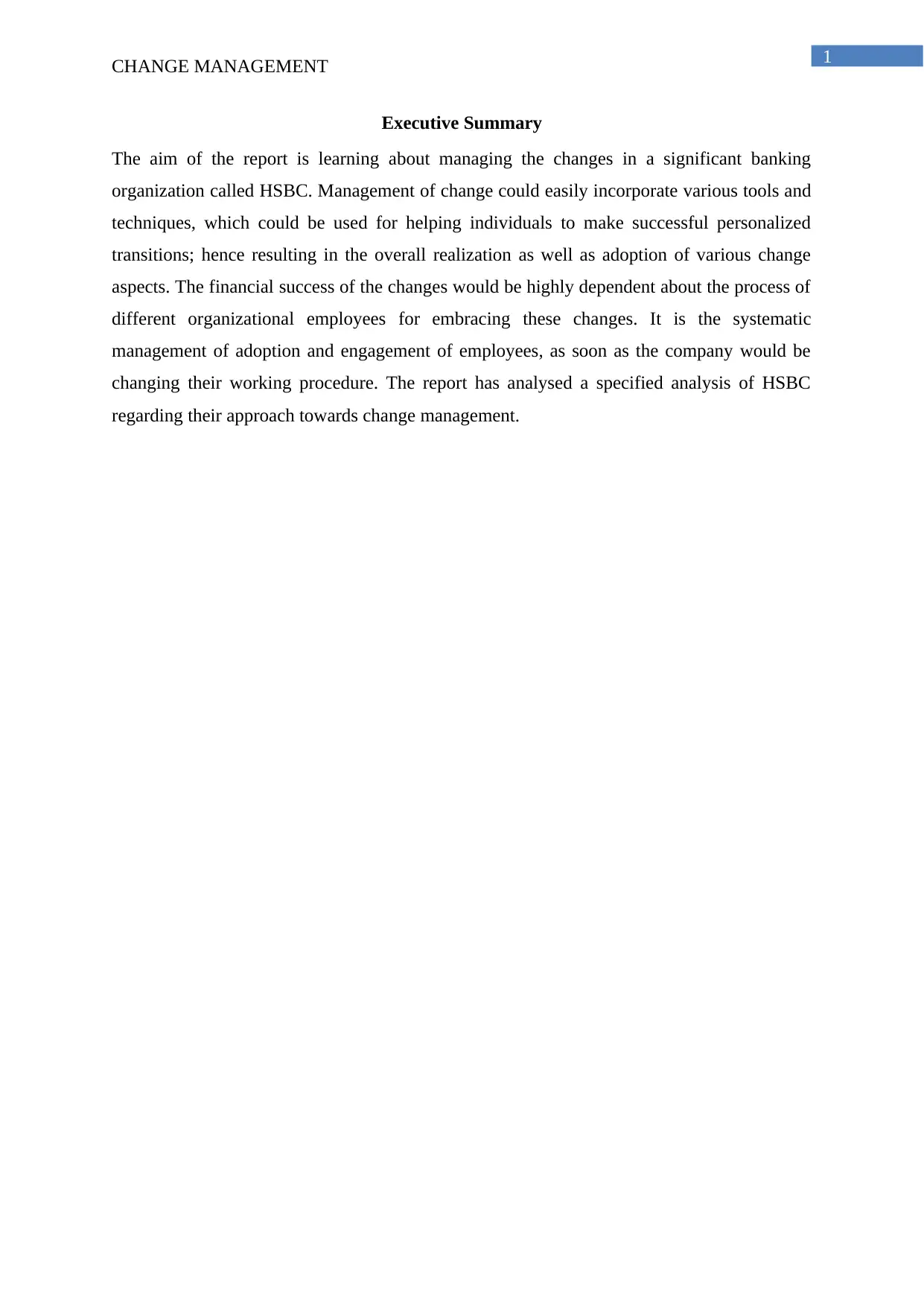
1
CHANGE MANAGEMENT
Executive Summary
The aim of the report is learning about managing the changes in a significant banking
organization called HSBC. Management of change could easily incorporate various tools and
techniques, which could be used for helping individuals to make successful personalized
transitions; hence resulting in the overall realization as well as adoption of various change
aspects. The financial success of the changes would be highly dependent about the process of
different organizational employees for embracing these changes. It is the systematic
management of adoption and engagement of employees, as soon as the company would be
changing their working procedure. The report has analysed a specified analysis of HSBC
regarding their approach towards change management.
CHANGE MANAGEMENT
Executive Summary
The aim of the report is learning about managing the changes in a significant banking
organization called HSBC. Management of change could easily incorporate various tools and
techniques, which could be used for helping individuals to make successful personalized
transitions; hence resulting in the overall realization as well as adoption of various change
aspects. The financial success of the changes would be highly dependent about the process of
different organizational employees for embracing these changes. It is the systematic
management of adoption and engagement of employees, as soon as the company would be
changing their working procedure. The report has analysed a specified analysis of HSBC
regarding their approach towards change management.
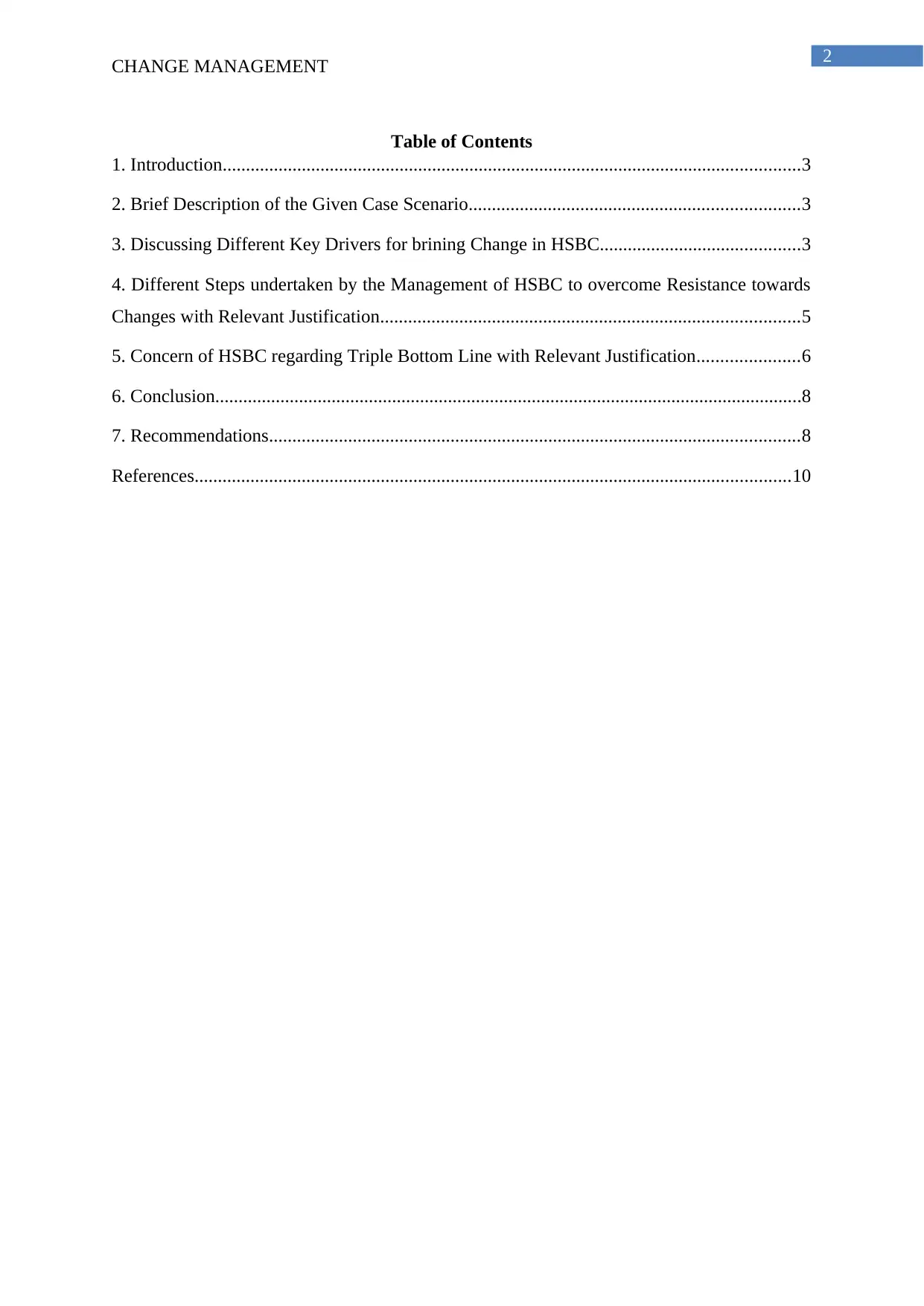
2
CHANGE MANAGEMENT
Table of Contents
1. Introduction............................................................................................................................3
2. Brief Description of the Given Case Scenario.......................................................................3
3. Discussing Different Key Drivers for brining Change in HSBC...........................................3
4. Different Steps undertaken by the Management of HSBC to overcome Resistance towards
Changes with Relevant Justification..........................................................................................5
5. Concern of HSBC regarding Triple Bottom Line with Relevant Justification......................6
6. Conclusion..............................................................................................................................8
7. Recommendations..................................................................................................................8
References................................................................................................................................10
CHANGE MANAGEMENT
Table of Contents
1. Introduction............................................................................................................................3
2. Brief Description of the Given Case Scenario.......................................................................3
3. Discussing Different Key Drivers for brining Change in HSBC...........................................3
4. Different Steps undertaken by the Management of HSBC to overcome Resistance towards
Changes with Relevant Justification..........................................................................................5
5. Concern of HSBC regarding Triple Bottom Line with Relevant Justification......................6
6. Conclusion..............................................................................................................................8
7. Recommendations..................................................................................................................8
References................................................................................................................................10
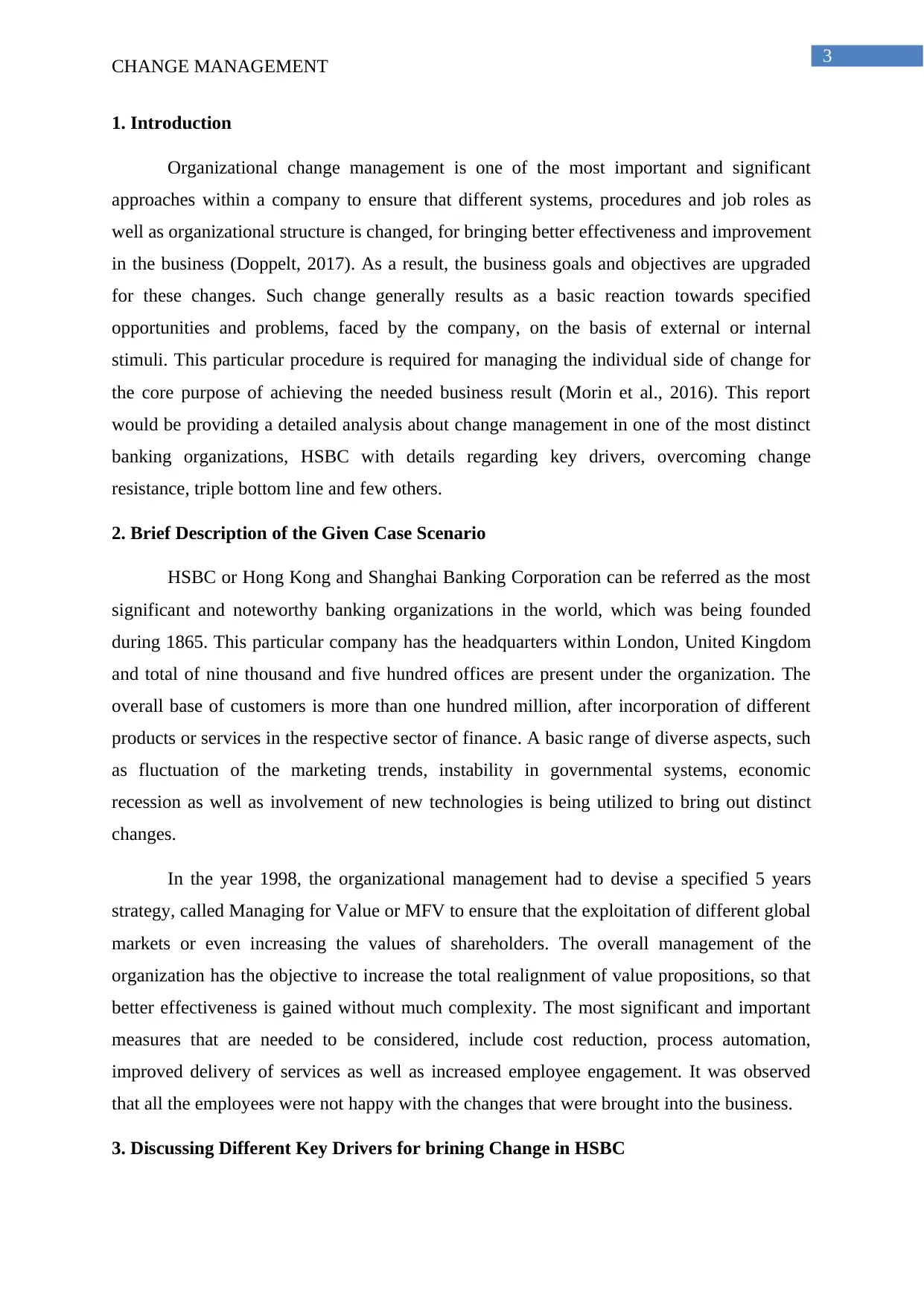
3
CHANGE MANAGEMENT
1. Introduction
Organizational change management is one of the most important and significant
approaches within a company to ensure that different systems, procedures and job roles as
well as organizational structure is changed, for bringing better effectiveness and improvement
in the business (Doppelt, 2017). As a result, the business goals and objectives are upgraded
for these changes. Such change generally results as a basic reaction towards specified
opportunities and problems, faced by the company, on the basis of external or internal
stimuli. This particular procedure is required for managing the individual side of change for
the core purpose of achieving the needed business result (Morin et al., 2016). This report
would be providing a detailed analysis about change management in one of the most distinct
banking organizations, HSBC with details regarding key drivers, overcoming change
resistance, triple bottom line and few others.
2. Brief Description of the Given Case Scenario
HSBC or Hong Kong and Shanghai Banking Corporation can be referred as the most
significant and noteworthy banking organizations in the world, which was being founded
during 1865. This particular company has the headquarters within London, United Kingdom
and total of nine thousand and five hundred offices are present under the organization. The
overall base of customers is more than one hundred million, after incorporation of different
products or services in the respective sector of finance. A basic range of diverse aspects, such
as fluctuation of the marketing trends, instability in governmental systems, economic
recession as well as involvement of new technologies is being utilized to bring out distinct
changes.
In the year 1998, the organizational management had to devise a specified 5 years
strategy, called Managing for Value or MFV to ensure that the exploitation of different global
markets or even increasing the values of shareholders. The overall management of the
organization has the objective to increase the total realignment of value propositions, so that
better effectiveness is gained without much complexity. The most significant and important
measures that are needed to be considered, include cost reduction, process automation,
improved delivery of services as well as increased employee engagement. It was observed
that all the employees were not happy with the changes that were brought into the business.
3. Discussing Different Key Drivers for brining Change in HSBC
CHANGE MANAGEMENT
1. Introduction
Organizational change management is one of the most important and significant
approaches within a company to ensure that different systems, procedures and job roles as
well as organizational structure is changed, for bringing better effectiveness and improvement
in the business (Doppelt, 2017). As a result, the business goals and objectives are upgraded
for these changes. Such change generally results as a basic reaction towards specified
opportunities and problems, faced by the company, on the basis of external or internal
stimuli. This particular procedure is required for managing the individual side of change for
the core purpose of achieving the needed business result (Morin et al., 2016). This report
would be providing a detailed analysis about change management in one of the most distinct
banking organizations, HSBC with details regarding key drivers, overcoming change
resistance, triple bottom line and few others.
2. Brief Description of the Given Case Scenario
HSBC or Hong Kong and Shanghai Banking Corporation can be referred as the most
significant and noteworthy banking organizations in the world, which was being founded
during 1865. This particular company has the headquarters within London, United Kingdom
and total of nine thousand and five hundred offices are present under the organization. The
overall base of customers is more than one hundred million, after incorporation of different
products or services in the respective sector of finance. A basic range of diverse aspects, such
as fluctuation of the marketing trends, instability in governmental systems, economic
recession as well as involvement of new technologies is being utilized to bring out distinct
changes.
In the year 1998, the organizational management had to devise a specified 5 years
strategy, called Managing for Value or MFV to ensure that the exploitation of different global
markets or even increasing the values of shareholders. The overall management of the
organization has the objective to increase the total realignment of value propositions, so that
better effectiveness is gained without much complexity. The most significant and important
measures that are needed to be considered, include cost reduction, process automation,
improved delivery of services as well as increased employee engagement. It was observed
that all the employees were not happy with the changes that were brought into the business.
3. Discussing Different Key Drivers for brining Change in HSBC
Secure Best Marks with AI Grader
Need help grading? Try our AI Grader for instant feedback on your assignments.
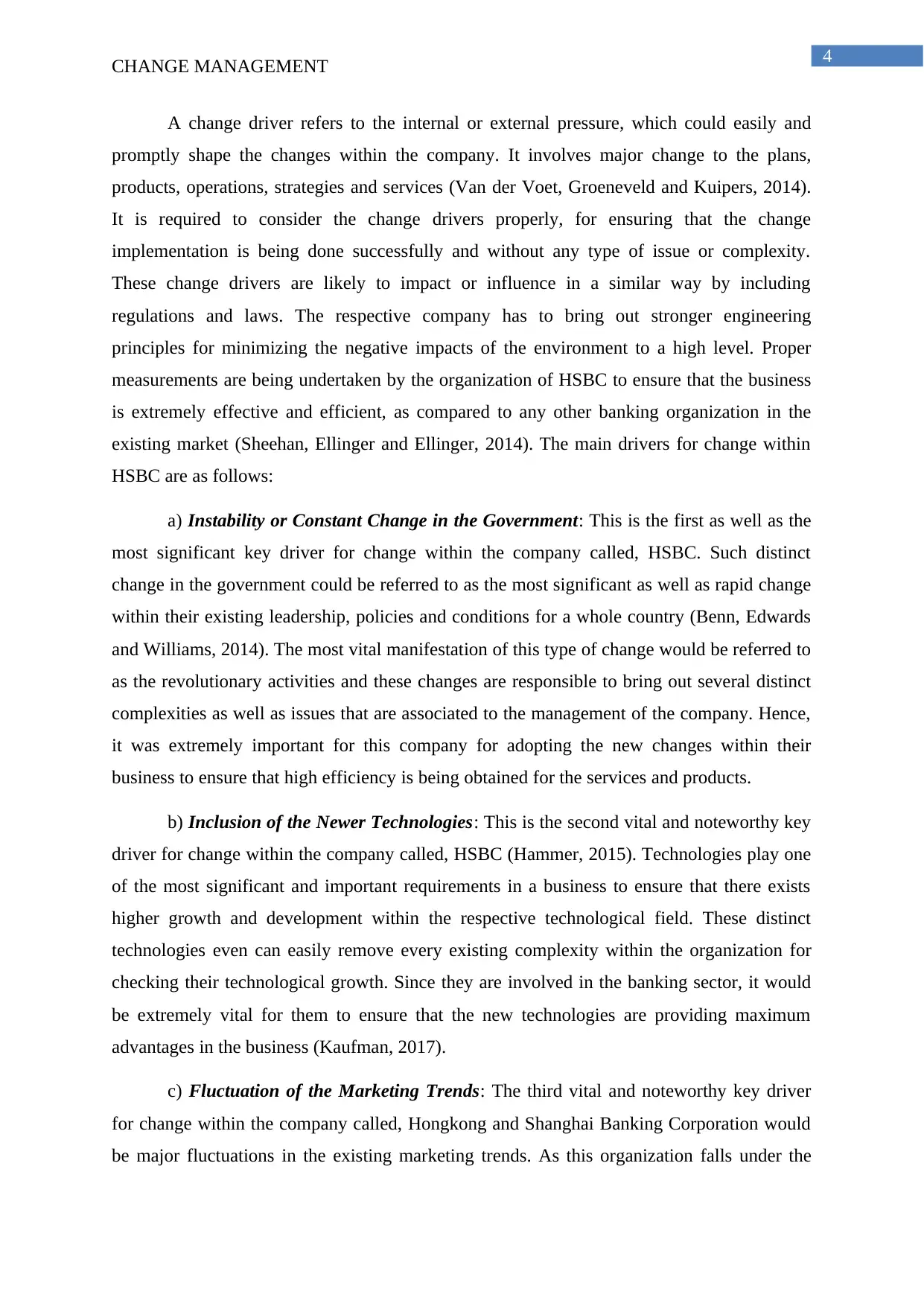
4
CHANGE MANAGEMENT
A change driver refers to the internal or external pressure, which could easily and
promptly shape the changes within the company. It involves major change to the plans,
products, operations, strategies and services (Van der Voet, Groeneveld and Kuipers, 2014).
It is required to consider the change drivers properly, for ensuring that the change
implementation is being done successfully and without any type of issue or complexity.
These change drivers are likely to impact or influence in a similar way by including
regulations and laws. The respective company has to bring out stronger engineering
principles for minimizing the negative impacts of the environment to a high level. Proper
measurements are being undertaken by the organization of HSBC to ensure that the business
is extremely effective and efficient, as compared to any other banking organization in the
existing market (Sheehan, Ellinger and Ellinger, 2014). The main drivers for change within
HSBC are as follows:
a) Instability or Constant Change in the Government: This is the first as well as the
most significant key driver for change within the company called, HSBC. Such distinct
change in the government could be referred to as the most significant as well as rapid change
within their existing leadership, policies and conditions for a whole country (Benn, Edwards
and Williams, 2014). The most vital manifestation of this type of change would be referred to
as the revolutionary activities and these changes are responsible to bring out several distinct
complexities as well as issues that are associated to the management of the company. Hence,
it was extremely important for this company for adopting the new changes within their
business to ensure that high efficiency is being obtained for the services and products.
b) Inclusion of the Newer Technologies: This is the second vital and noteworthy key
driver for change within the company called, HSBC (Hammer, 2015). Technologies play one
of the most significant and important requirements in a business to ensure that there exists
higher growth and development within the respective technological field. These distinct
technologies even can easily remove every existing complexity within the organization for
checking their technological growth. Since they are involved in the banking sector, it would
be extremely vital for them to ensure that the new technologies are providing maximum
advantages in the business (Kaufman, 2017).
c) Fluctuation of the Marketing Trends: The third vital and noteworthy key driver
for change within the company called, Hongkong and Shanghai Banking Corporation would
be major fluctuations in the existing marketing trends. As this organization falls under the
CHANGE MANAGEMENT
A change driver refers to the internal or external pressure, which could easily and
promptly shape the changes within the company. It involves major change to the plans,
products, operations, strategies and services (Van der Voet, Groeneveld and Kuipers, 2014).
It is required to consider the change drivers properly, for ensuring that the change
implementation is being done successfully and without any type of issue or complexity.
These change drivers are likely to impact or influence in a similar way by including
regulations and laws. The respective company has to bring out stronger engineering
principles for minimizing the negative impacts of the environment to a high level. Proper
measurements are being undertaken by the organization of HSBC to ensure that the business
is extremely effective and efficient, as compared to any other banking organization in the
existing market (Sheehan, Ellinger and Ellinger, 2014). The main drivers for change within
HSBC are as follows:
a) Instability or Constant Change in the Government: This is the first as well as the
most significant key driver for change within the company called, HSBC. Such distinct
change in the government could be referred to as the most significant as well as rapid change
within their existing leadership, policies and conditions for a whole country (Benn, Edwards
and Williams, 2014). The most vital manifestation of this type of change would be referred to
as the revolutionary activities and these changes are responsible to bring out several distinct
complexities as well as issues that are associated to the management of the company. Hence,
it was extremely important for this company for adopting the new changes within their
business to ensure that high efficiency is being obtained for the services and products.
b) Inclusion of the Newer Technologies: This is the second vital and noteworthy key
driver for change within the company called, HSBC (Hammer, 2015). Technologies play one
of the most significant and important requirements in a business to ensure that there exists
higher growth and development within the respective technological field. These distinct
technologies even can easily remove every existing complexity within the organization for
checking their technological growth. Since they are involved in the banking sector, it would
be extremely vital for them to ensure that the new technologies are providing maximum
advantages in the business (Kaufman, 2017).
c) Fluctuation of the Marketing Trends: The third vital and noteworthy key driver
for change within the company called, Hongkong and Shanghai Banking Corporation would
be major fluctuations in the existing marketing trends. As this organization falls under the
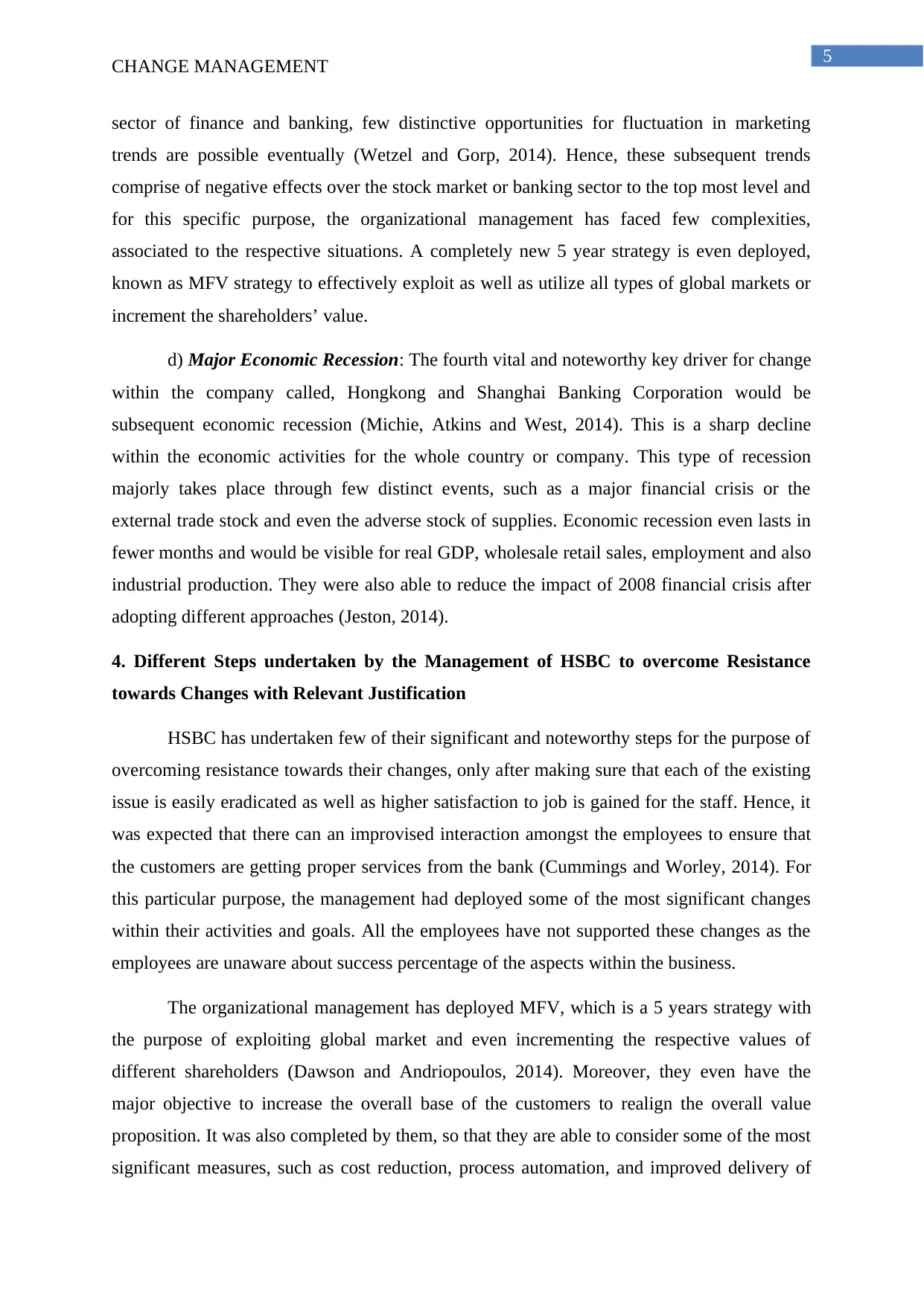
5
CHANGE MANAGEMENT
sector of finance and banking, few distinctive opportunities for fluctuation in marketing
trends are possible eventually (Wetzel and Gorp, 2014). Hence, these subsequent trends
comprise of negative effects over the stock market or banking sector to the top most level and
for this specific purpose, the organizational management has faced few complexities,
associated to the respective situations. A completely new 5 year strategy is even deployed,
known as MFV strategy to effectively exploit as well as utilize all types of global markets or
increment the shareholders’ value.
d) Major Economic Recession: The fourth vital and noteworthy key driver for change
within the company called, Hongkong and Shanghai Banking Corporation would be
subsequent economic recession (Michie, Atkins and West, 2014). This is a sharp decline
within the economic activities for the whole country or company. This type of recession
majorly takes place through few distinct events, such as a major financial crisis or the
external trade stock and even the adverse stock of supplies. Economic recession even lasts in
fewer months and would be visible for real GDP, wholesale retail sales, employment and also
industrial production. They were also able to reduce the impact of 2008 financial crisis after
adopting different approaches (Jeston, 2014).
4. Different Steps undertaken by the Management of HSBC to overcome Resistance
towards Changes with Relevant Justification
HSBC has undertaken few of their significant and noteworthy steps for the purpose of
overcoming resistance towards their changes, only after making sure that each of the existing
issue is easily eradicated as well as higher satisfaction to job is gained for the staff. Hence, it
was expected that there can an improvised interaction amongst the employees to ensure that
the customers are getting proper services from the bank (Cummings and Worley, 2014). For
this particular purpose, the management had deployed some of the most significant changes
within their activities and goals. All the employees have not supported these changes as the
employees are unaware about success percentage of the aspects within the business.
The organizational management has deployed MFV, which is a 5 years strategy with
the purpose of exploiting global market and even incrementing the respective values of
different shareholders (Dawson and Andriopoulos, 2014). Moreover, they even have the
major objective to increase the overall base of the customers to realign the overall value
proposition. It was also completed by them, so that they are able to consider some of the most
significant measures, such as cost reduction, process automation, and improved delivery of
CHANGE MANAGEMENT
sector of finance and banking, few distinctive opportunities for fluctuation in marketing
trends are possible eventually (Wetzel and Gorp, 2014). Hence, these subsequent trends
comprise of negative effects over the stock market or banking sector to the top most level and
for this specific purpose, the organizational management has faced few complexities,
associated to the respective situations. A completely new 5 year strategy is even deployed,
known as MFV strategy to effectively exploit as well as utilize all types of global markets or
increment the shareholders’ value.
d) Major Economic Recession: The fourth vital and noteworthy key driver for change
within the company called, Hongkong and Shanghai Banking Corporation would be
subsequent economic recession (Michie, Atkins and West, 2014). This is a sharp decline
within the economic activities for the whole country or company. This type of recession
majorly takes place through few distinct events, such as a major financial crisis or the
external trade stock and even the adverse stock of supplies. Economic recession even lasts in
fewer months and would be visible for real GDP, wholesale retail sales, employment and also
industrial production. They were also able to reduce the impact of 2008 financial crisis after
adopting different approaches (Jeston, 2014).
4. Different Steps undertaken by the Management of HSBC to overcome Resistance
towards Changes with Relevant Justification
HSBC has undertaken few of their significant and noteworthy steps for the purpose of
overcoming resistance towards their changes, only after making sure that each of the existing
issue is easily eradicated as well as higher satisfaction to job is gained for the staff. Hence, it
was expected that there can an improvised interaction amongst the employees to ensure that
the customers are getting proper services from the bank (Cummings and Worley, 2014). For
this particular purpose, the management had deployed some of the most significant changes
within their activities and goals. All the employees have not supported these changes as the
employees are unaware about success percentage of the aspects within the business.
The organizational management has deployed MFV, which is a 5 years strategy with
the purpose of exploiting global market and even incrementing the respective values of
different shareholders (Dawson and Andriopoulos, 2014). Moreover, they even have the
major objective to increase the overall base of the customers to realign the overall value
proposition. It was also completed by them, so that they are able to consider some of the most
significant measures, such as cost reduction, process automation, and improved delivery of
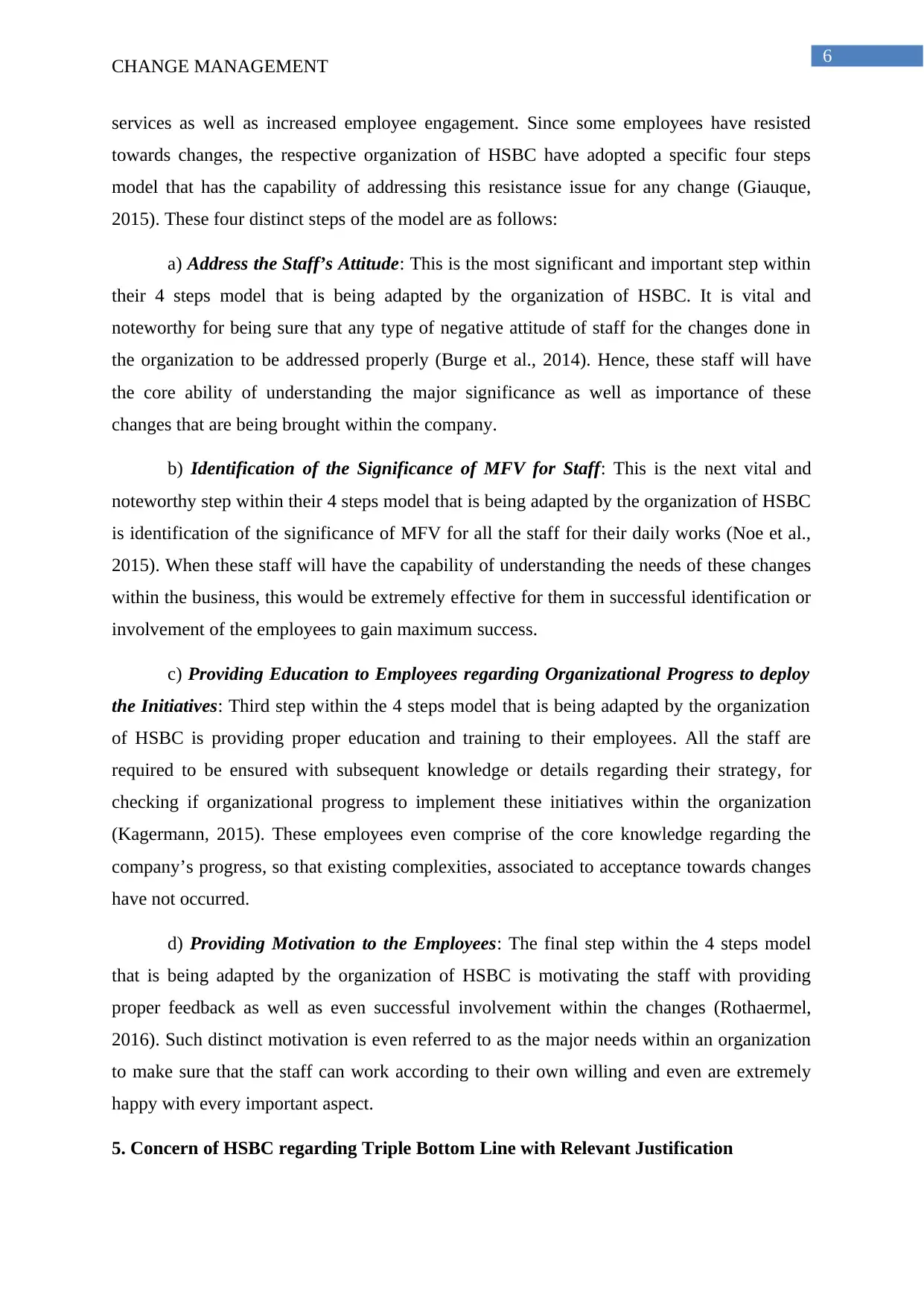
6
CHANGE MANAGEMENT
services as well as increased employee engagement. Since some employees have resisted
towards changes, the respective organization of HSBC have adopted a specific four steps
model that has the capability of addressing this resistance issue for any change (Giauque,
2015). These four distinct steps of the model are as follows:
a) Address the Staff’s Attitude: This is the most significant and important step within
their 4 steps model that is being adapted by the organization of HSBC. It is vital and
noteworthy for being sure that any type of negative attitude of staff for the changes done in
the organization to be addressed properly (Burge et al., 2014). Hence, these staff will have
the core ability of understanding the major significance as well as importance of these
changes that are being brought within the company.
b) Identification of the Significance of MFV for Staff: This is the next vital and
noteworthy step within their 4 steps model that is being adapted by the organization of HSBC
is identification of the significance of MFV for all the staff for their daily works (Noe et al.,
2015). When these staff will have the capability of understanding the needs of these changes
within the business, this would be extremely effective for them in successful identification or
involvement of the employees to gain maximum success.
c) Providing Education to Employees regarding Organizational Progress to deploy
the Initiatives: Third step within the 4 steps model that is being adapted by the organization
of HSBC is providing proper education and training to their employees. All the staff are
required to be ensured with subsequent knowledge or details regarding their strategy, for
checking if organizational progress to implement these initiatives within the organization
(Kagermann, 2015). These employees even comprise of the core knowledge regarding the
company’s progress, so that existing complexities, associated to acceptance towards changes
have not occurred.
d) Providing Motivation to the Employees: The final step within the 4 steps model
that is being adapted by the organization of HSBC is motivating the staff with providing
proper feedback as well as even successful involvement within the changes (Rothaermel,
2016). Such distinct motivation is even referred to as the major needs within an organization
to make sure that the staff can work according to their own willing and even are extremely
happy with every important aspect.
5. Concern of HSBC regarding Triple Bottom Line with Relevant Justification
CHANGE MANAGEMENT
services as well as increased employee engagement. Since some employees have resisted
towards changes, the respective organization of HSBC have adopted a specific four steps
model that has the capability of addressing this resistance issue for any change (Giauque,
2015). These four distinct steps of the model are as follows:
a) Address the Staff’s Attitude: This is the most significant and important step within
their 4 steps model that is being adapted by the organization of HSBC. It is vital and
noteworthy for being sure that any type of negative attitude of staff for the changes done in
the organization to be addressed properly (Burge et al., 2014). Hence, these staff will have
the core ability of understanding the major significance as well as importance of these
changes that are being brought within the company.
b) Identification of the Significance of MFV for Staff: This is the next vital and
noteworthy step within their 4 steps model that is being adapted by the organization of HSBC
is identification of the significance of MFV for all the staff for their daily works (Noe et al.,
2015). When these staff will have the capability of understanding the needs of these changes
within the business, this would be extremely effective for them in successful identification or
involvement of the employees to gain maximum success.
c) Providing Education to Employees regarding Organizational Progress to deploy
the Initiatives: Third step within the 4 steps model that is being adapted by the organization
of HSBC is providing proper education and training to their employees. All the staff are
required to be ensured with subsequent knowledge or details regarding their strategy, for
checking if organizational progress to implement these initiatives within the organization
(Kagermann, 2015). These employees even comprise of the core knowledge regarding the
company’s progress, so that existing complexities, associated to acceptance towards changes
have not occurred.
d) Providing Motivation to the Employees: The final step within the 4 steps model
that is being adapted by the organization of HSBC is motivating the staff with providing
proper feedback as well as even successful involvement within the changes (Rothaermel,
2016). Such distinct motivation is even referred to as the major needs within an organization
to make sure that the staff can work according to their own willing and even are extremely
happy with every important aspect.
5. Concern of HSBC regarding Triple Bottom Line with Relevant Justification
Paraphrase This Document
Need a fresh take? Get an instant paraphrase of this document with our AI Paraphraser
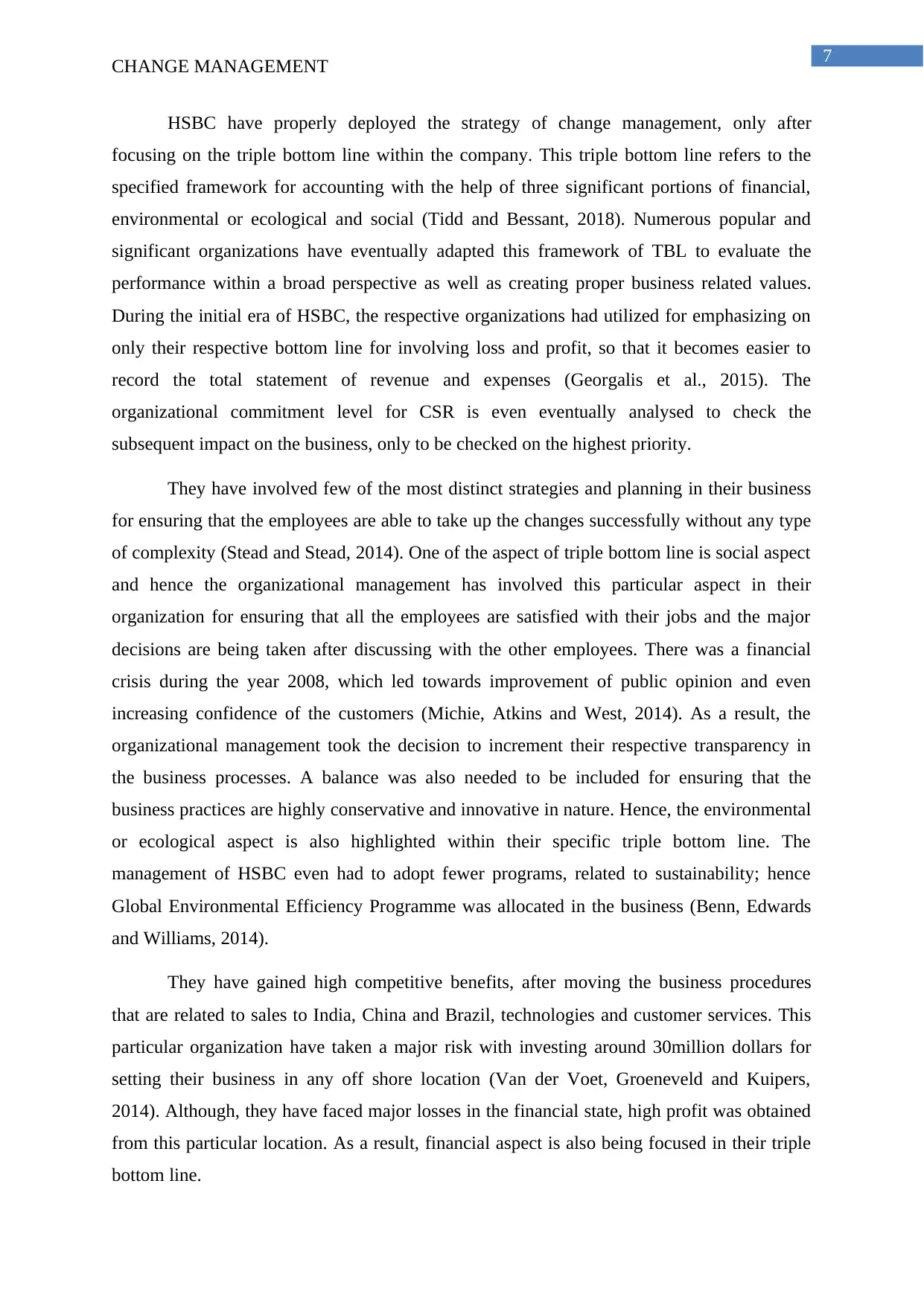
7
CHANGE MANAGEMENT
HSBC have properly deployed the strategy of change management, only after
focusing on the triple bottom line within the company. This triple bottom line refers to the
specified framework for accounting with the help of three significant portions of financial,
environmental or ecological and social (Tidd and Bessant, 2018). Numerous popular and
significant organizations have eventually adapted this framework of TBL to evaluate the
performance within a broad perspective as well as creating proper business related values.
During the initial era of HSBC, the respective organizations had utilized for emphasizing on
only their respective bottom line for involving loss and profit, so that it becomes easier to
record the total statement of revenue and expenses (Georgalis et al., 2015). The
organizational commitment level for CSR is even eventually analysed to check the
subsequent impact on the business, only to be checked on the highest priority.
They have involved few of the most distinct strategies and planning in their business
for ensuring that the employees are able to take up the changes successfully without any type
of complexity (Stead and Stead, 2014). One of the aspect of triple bottom line is social aspect
and hence the organizational management has involved this particular aspect in their
organization for ensuring that all the employees are satisfied with their jobs and the major
decisions are being taken after discussing with the other employees. There was a financial
crisis during the year 2008, which led towards improvement of public opinion and even
increasing confidence of the customers (Michie, Atkins and West, 2014). As a result, the
organizational management took the decision to increment their respective transparency in
the business processes. A balance was also needed to be included for ensuring that the
business practices are highly conservative and innovative in nature. Hence, the environmental
or ecological aspect is also highlighted within their specific triple bottom line. The
management of HSBC even had to adopt fewer programs, related to sustainability; hence
Global Environmental Efficiency Programme was allocated in the business (Benn, Edwards
and Williams, 2014).
They have gained high competitive benefits, after moving the business procedures
that are related to sales to India, China and Brazil, technologies and customer services. This
particular organization have taken a major risk with investing around 30million dollars for
setting their business in any off shore location (Van der Voet, Groeneveld and Kuipers,
2014). Although, they have faced major losses in the financial state, high profit was obtained
from this particular location. As a result, financial aspect is also being focused in their triple
bottom line.
CHANGE MANAGEMENT
HSBC have properly deployed the strategy of change management, only after
focusing on the triple bottom line within the company. This triple bottom line refers to the
specified framework for accounting with the help of three significant portions of financial,
environmental or ecological and social (Tidd and Bessant, 2018). Numerous popular and
significant organizations have eventually adapted this framework of TBL to evaluate the
performance within a broad perspective as well as creating proper business related values.
During the initial era of HSBC, the respective organizations had utilized for emphasizing on
only their respective bottom line for involving loss and profit, so that it becomes easier to
record the total statement of revenue and expenses (Georgalis et al., 2015). The
organizational commitment level for CSR is even eventually analysed to check the
subsequent impact on the business, only to be checked on the highest priority.
They have involved few of the most distinct strategies and planning in their business
for ensuring that the employees are able to take up the changes successfully without any type
of complexity (Stead and Stead, 2014). One of the aspect of triple bottom line is social aspect
and hence the organizational management has involved this particular aspect in their
organization for ensuring that all the employees are satisfied with their jobs and the major
decisions are being taken after discussing with the other employees. There was a financial
crisis during the year 2008, which led towards improvement of public opinion and even
increasing confidence of the customers (Michie, Atkins and West, 2014). As a result, the
organizational management took the decision to increment their respective transparency in
the business processes. A balance was also needed to be included for ensuring that the
business practices are highly conservative and innovative in nature. Hence, the environmental
or ecological aspect is also highlighted within their specific triple bottom line. The
management of HSBC even had to adopt fewer programs, related to sustainability; hence
Global Environmental Efficiency Programme was allocated in the business (Benn, Edwards
and Williams, 2014).
They have gained high competitive benefits, after moving the business procedures
that are related to sales to India, China and Brazil, technologies and customer services. This
particular organization have taken a major risk with investing around 30million dollars for
setting their business in any off shore location (Van der Voet, Groeneveld and Kuipers,
2014). Although, they have faced major losses in the financial state, high profit was obtained
from this particular location. As a result, financial aspect is also being focused in their triple
bottom line.
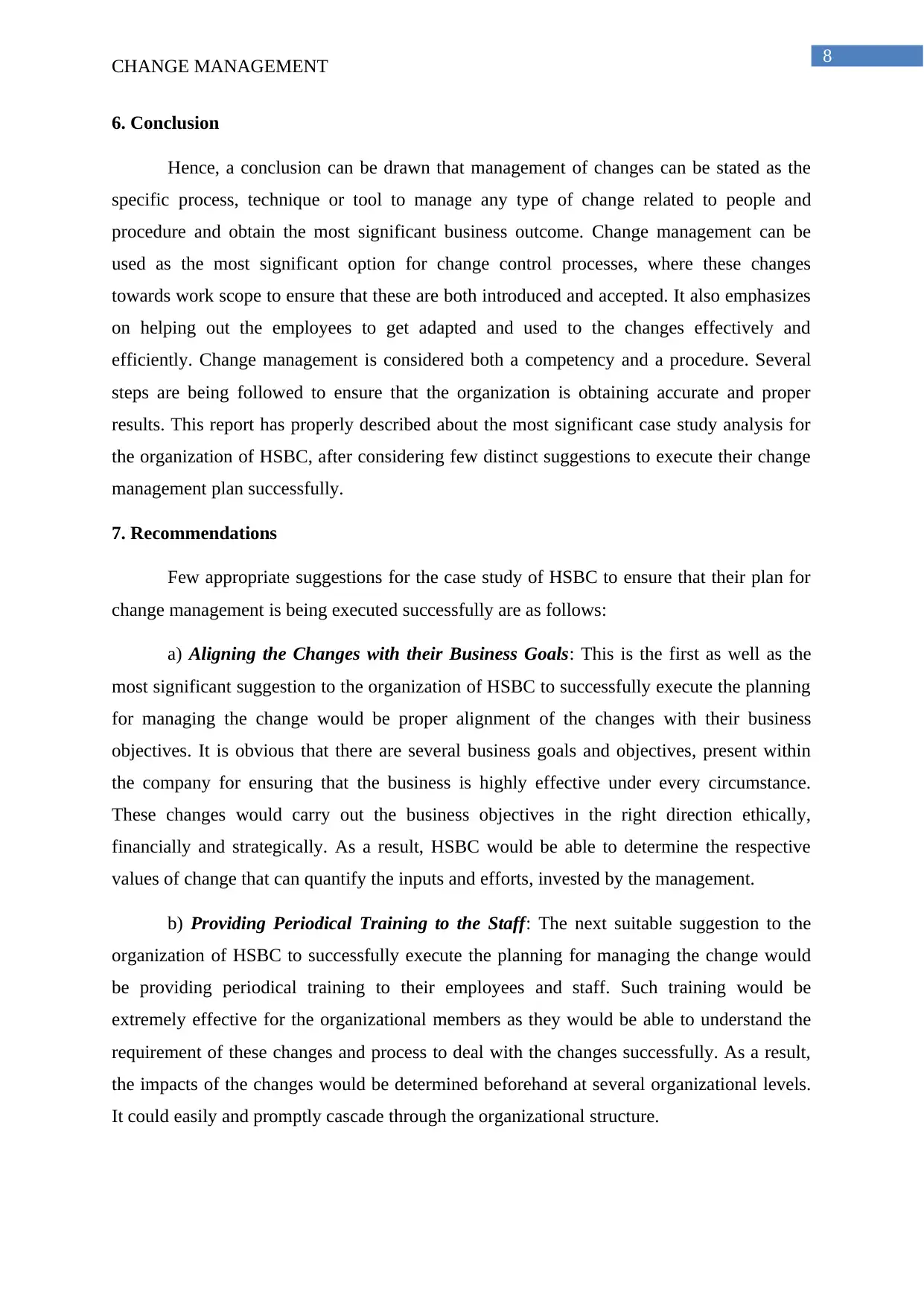
8
CHANGE MANAGEMENT
6. Conclusion
Hence, a conclusion can be drawn that management of changes can be stated as the
specific process, technique or tool to manage any type of change related to people and
procedure and obtain the most significant business outcome. Change management can be
used as the most significant option for change control processes, where these changes
towards work scope to ensure that these are both introduced and accepted. It also emphasizes
on helping out the employees to get adapted and used to the changes effectively and
efficiently. Change management is considered both a competency and a procedure. Several
steps are being followed to ensure that the organization is obtaining accurate and proper
results. This report has properly described about the most significant case study analysis for
the organization of HSBC, after considering few distinct suggestions to execute their change
management plan successfully.
7. Recommendations
Few appropriate suggestions for the case study of HSBC to ensure that their plan for
change management is being executed successfully are as follows:
a) Aligning the Changes with their Business Goals: This is the first as well as the
most significant suggestion to the organization of HSBC to successfully execute the planning
for managing the change would be proper alignment of the changes with their business
objectives. It is obvious that there are several business goals and objectives, present within
the company for ensuring that the business is highly effective under every circumstance.
These changes would carry out the business objectives in the right direction ethically,
financially and strategically. As a result, HSBC would be able to determine the respective
values of change that can quantify the inputs and efforts, invested by the management.
b) Providing Periodical Training to the Staff: The next suitable suggestion to the
organization of HSBC to successfully execute the planning for managing the change would
be providing periodical training to their employees and staff. Such training would be
extremely effective for the organizational members as they would be able to understand the
requirement of these changes and process to deal with the changes successfully. As a result,
the impacts of the changes would be determined beforehand at several organizational levels.
It could easily and promptly cascade through the organizational structure.
CHANGE MANAGEMENT
6. Conclusion
Hence, a conclusion can be drawn that management of changes can be stated as the
specific process, technique or tool to manage any type of change related to people and
procedure and obtain the most significant business outcome. Change management can be
used as the most significant option for change control processes, where these changes
towards work scope to ensure that these are both introduced and accepted. It also emphasizes
on helping out the employees to get adapted and used to the changes effectively and
efficiently. Change management is considered both a competency and a procedure. Several
steps are being followed to ensure that the organization is obtaining accurate and proper
results. This report has properly described about the most significant case study analysis for
the organization of HSBC, after considering few distinct suggestions to execute their change
management plan successfully.
7. Recommendations
Few appropriate suggestions for the case study of HSBC to ensure that their plan for
change management is being executed successfully are as follows:
a) Aligning the Changes with their Business Goals: This is the first as well as the
most significant suggestion to the organization of HSBC to successfully execute the planning
for managing the change would be proper alignment of the changes with their business
objectives. It is obvious that there are several business goals and objectives, present within
the company for ensuring that the business is highly effective under every circumstance.
These changes would carry out the business objectives in the right direction ethically,
financially and strategically. As a result, HSBC would be able to determine the respective
values of change that can quantify the inputs and efforts, invested by the management.
b) Providing Periodical Training to the Staff: The next suitable suggestion to the
organization of HSBC to successfully execute the planning for managing the change would
be providing periodical training to their employees and staff. Such training would be
extremely effective for the organizational members as they would be able to understand the
requirement of these changes and process to deal with the changes successfully. As a result,
the impacts of the changes would be determined beforehand at several organizational levels.
It could easily and promptly cascade through the organizational structure.
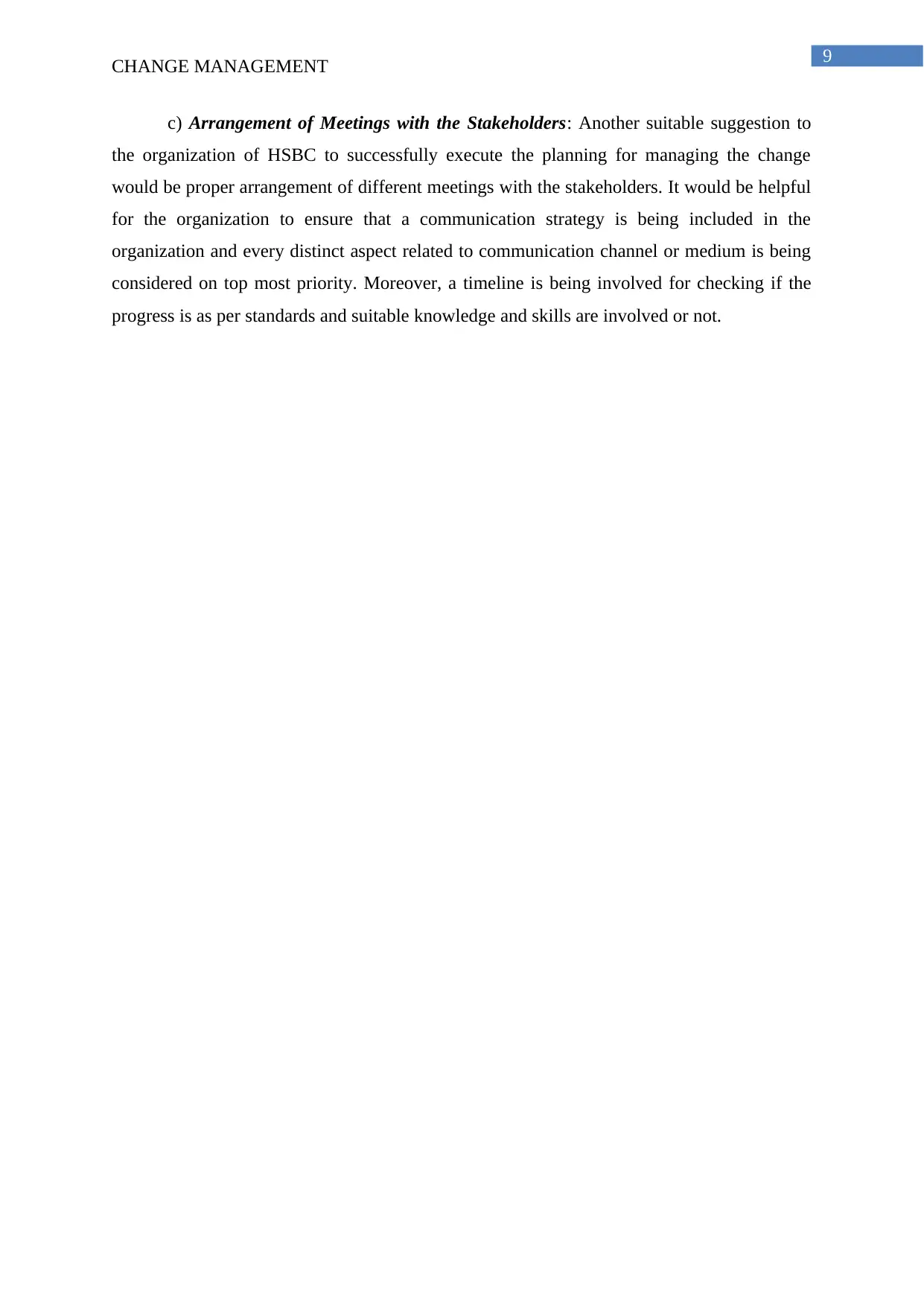
9
CHANGE MANAGEMENT
c) Arrangement of Meetings with the Stakeholders: Another suitable suggestion to
the organization of HSBC to successfully execute the planning for managing the change
would be proper arrangement of different meetings with the stakeholders. It would be helpful
for the organization to ensure that a communication strategy is being included in the
organization and every distinct aspect related to communication channel or medium is being
considered on top most priority. Moreover, a timeline is being involved for checking if the
progress is as per standards and suitable knowledge and skills are involved or not.
CHANGE MANAGEMENT
c) Arrangement of Meetings with the Stakeholders: Another suitable suggestion to
the organization of HSBC to successfully execute the planning for managing the change
would be proper arrangement of different meetings with the stakeholders. It would be helpful
for the organization to ensure that a communication strategy is being included in the
organization and every distinct aspect related to communication channel or medium is being
considered on top most priority. Moreover, a timeline is being involved for checking if the
progress is as per standards and suitable knowledge and skills are involved or not.
Secure Best Marks with AI Grader
Need help grading? Try our AI Grader for instant feedback on your assignments.
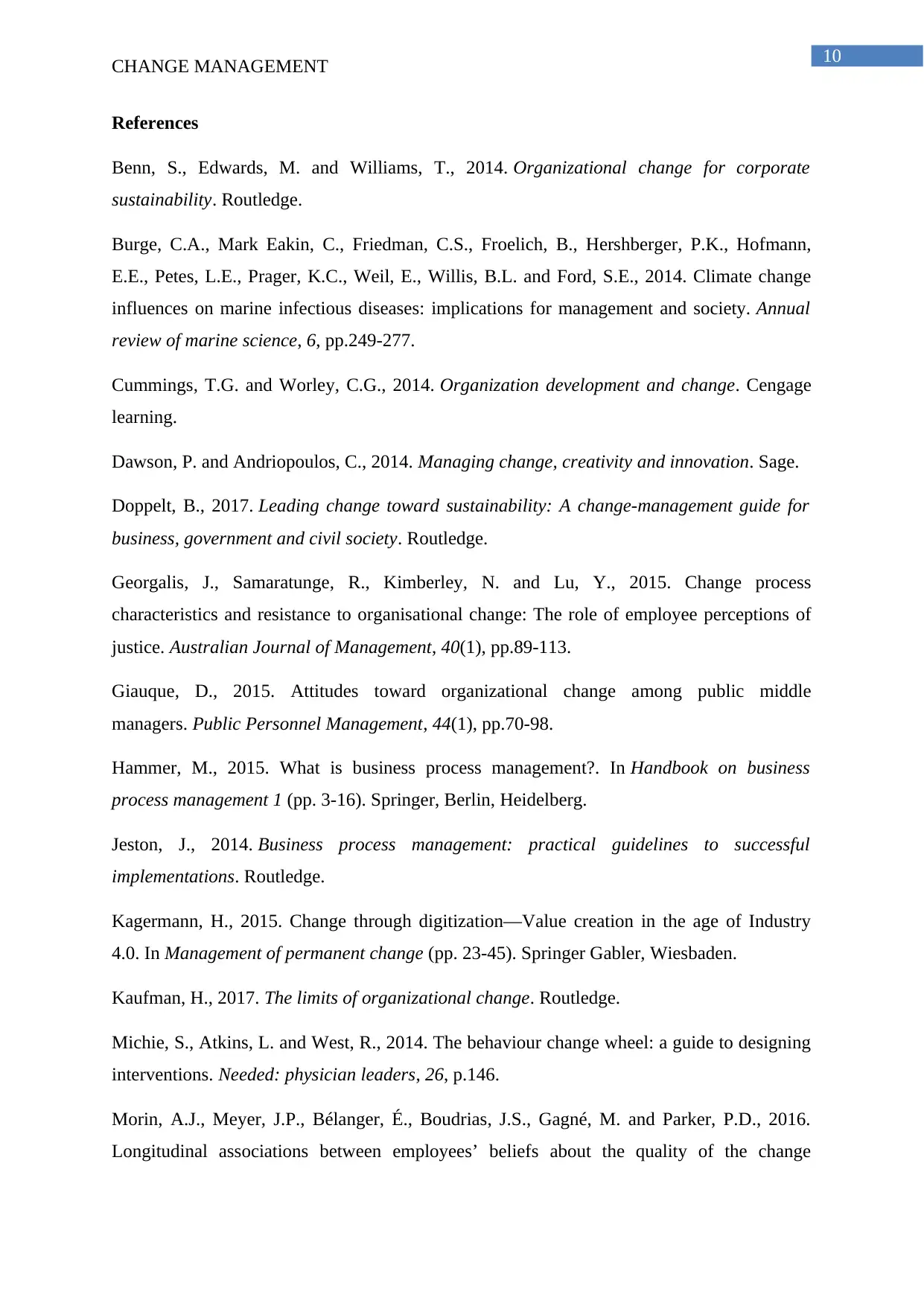
10
CHANGE MANAGEMENT
References
Benn, S., Edwards, M. and Williams, T., 2014. Organizational change for corporate
sustainability. Routledge.
Burge, C.A., Mark Eakin, C., Friedman, C.S., Froelich, B., Hershberger, P.K., Hofmann,
E.E., Petes, L.E., Prager, K.C., Weil, E., Willis, B.L. and Ford, S.E., 2014. Climate change
influences on marine infectious diseases: implications for management and society. Annual
review of marine science, 6, pp.249-277.
Cummings, T.G. and Worley, C.G., 2014. Organization development and change. Cengage
learning.
Dawson, P. and Andriopoulos, C., 2014. Managing change, creativity and innovation. Sage.
Doppelt, B., 2017. Leading change toward sustainability: A change-management guide for
business, government and civil society. Routledge.
Georgalis, J., Samaratunge, R., Kimberley, N. and Lu, Y., 2015. Change process
characteristics and resistance to organisational change: The role of employee perceptions of
justice. Australian Journal of Management, 40(1), pp.89-113.
Giauque, D., 2015. Attitudes toward organizational change among public middle
managers. Public Personnel Management, 44(1), pp.70-98.
Hammer, M., 2015. What is business process management?. In Handbook on business
process management 1 (pp. 3-16). Springer, Berlin, Heidelberg.
Jeston, J., 2014. Business process management: practical guidelines to successful
implementations. Routledge.
Kagermann, H., 2015. Change through digitization—Value creation in the age of Industry
4.0. In Management of permanent change (pp. 23-45). Springer Gabler, Wiesbaden.
Kaufman, H., 2017. The limits of organizational change. Routledge.
Michie, S., Atkins, L. and West, R., 2014. The behaviour change wheel: a guide to designing
interventions. Needed: physician leaders, 26, p.146.
Morin, A.J., Meyer, J.P., Bélanger, É., Boudrias, J.S., Gagné, M. and Parker, P.D., 2016.
Longitudinal associations between employees’ beliefs about the quality of the change
CHANGE MANAGEMENT
References
Benn, S., Edwards, M. and Williams, T., 2014. Organizational change for corporate
sustainability. Routledge.
Burge, C.A., Mark Eakin, C., Friedman, C.S., Froelich, B., Hershberger, P.K., Hofmann,
E.E., Petes, L.E., Prager, K.C., Weil, E., Willis, B.L. and Ford, S.E., 2014. Climate change
influences on marine infectious diseases: implications for management and society. Annual
review of marine science, 6, pp.249-277.
Cummings, T.G. and Worley, C.G., 2014. Organization development and change. Cengage
learning.
Dawson, P. and Andriopoulos, C., 2014. Managing change, creativity and innovation. Sage.
Doppelt, B., 2017. Leading change toward sustainability: A change-management guide for
business, government and civil society. Routledge.
Georgalis, J., Samaratunge, R., Kimberley, N. and Lu, Y., 2015. Change process
characteristics and resistance to organisational change: The role of employee perceptions of
justice. Australian Journal of Management, 40(1), pp.89-113.
Giauque, D., 2015. Attitudes toward organizational change among public middle
managers. Public Personnel Management, 44(1), pp.70-98.
Hammer, M., 2015. What is business process management?. In Handbook on business
process management 1 (pp. 3-16). Springer, Berlin, Heidelberg.
Jeston, J., 2014. Business process management: practical guidelines to successful
implementations. Routledge.
Kagermann, H., 2015. Change through digitization—Value creation in the age of Industry
4.0. In Management of permanent change (pp. 23-45). Springer Gabler, Wiesbaden.
Kaufman, H., 2017. The limits of organizational change. Routledge.
Michie, S., Atkins, L. and West, R., 2014. The behaviour change wheel: a guide to designing
interventions. Needed: physician leaders, 26, p.146.
Morin, A.J., Meyer, J.P., Bélanger, É., Boudrias, J.S., Gagné, M. and Parker, P.D., 2016.
Longitudinal associations between employees’ beliefs about the quality of the change
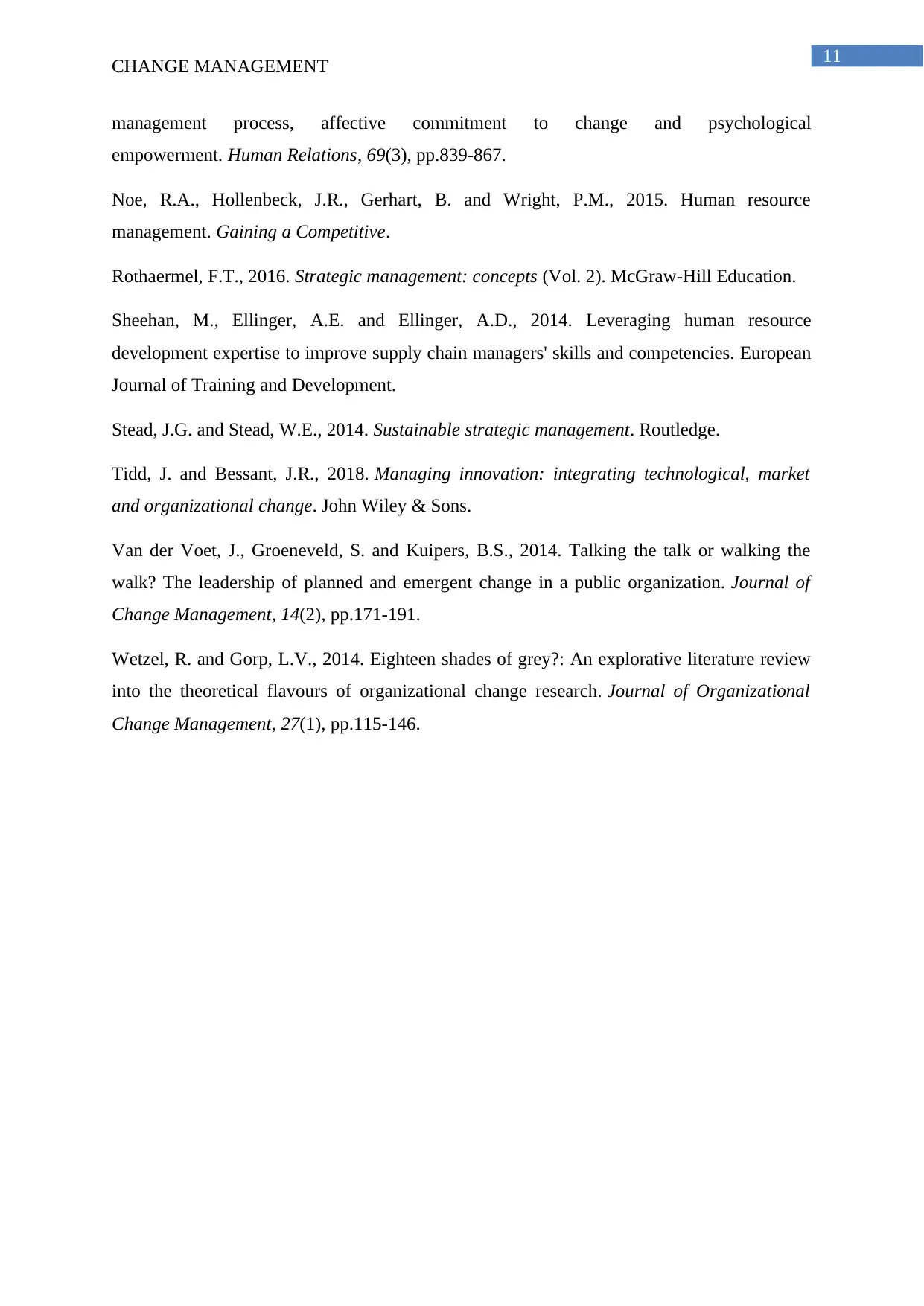
11
CHANGE MANAGEMENT
management process, affective commitment to change and psychological
empowerment. Human Relations, 69(3), pp.839-867.
Noe, R.A., Hollenbeck, J.R., Gerhart, B. and Wright, P.M., 2015. Human resource
management. Gaining a Competitive.
Rothaermel, F.T., 2016. Strategic management: concepts (Vol. 2). McGraw-Hill Education.
Sheehan, M., Ellinger, A.E. and Ellinger, A.D., 2014. Leveraging human resource
development expertise to improve supply chain managers' skills and competencies. European
Journal of Training and Development.
Stead, J.G. and Stead, W.E., 2014. Sustainable strategic management. Routledge.
Tidd, J. and Bessant, J.R., 2018. Managing innovation: integrating technological, market
and organizational change. John Wiley & Sons.
Van der Voet, J., Groeneveld, S. and Kuipers, B.S., 2014. Talking the talk or walking the
walk? The leadership of planned and emergent change in a public organization. Journal of
Change Management, 14(2), pp.171-191.
Wetzel, R. and Gorp, L.V., 2014. Eighteen shades of grey?: An explorative literature review
into the theoretical flavours of organizational change research. Journal of Organizational
Change Management, 27(1), pp.115-146.
CHANGE MANAGEMENT
management process, affective commitment to change and psychological
empowerment. Human Relations, 69(3), pp.839-867.
Noe, R.A., Hollenbeck, J.R., Gerhart, B. and Wright, P.M., 2015. Human resource
management. Gaining a Competitive.
Rothaermel, F.T., 2016. Strategic management: concepts (Vol. 2). McGraw-Hill Education.
Sheehan, M., Ellinger, A.E. and Ellinger, A.D., 2014. Leveraging human resource
development expertise to improve supply chain managers' skills and competencies. European
Journal of Training and Development.
Stead, J.G. and Stead, W.E., 2014. Sustainable strategic management. Routledge.
Tidd, J. and Bessant, J.R., 2018. Managing innovation: integrating technological, market
and organizational change. John Wiley & Sons.
Van der Voet, J., Groeneveld, S. and Kuipers, B.S., 2014. Talking the talk or walking the
walk? The leadership of planned and emergent change in a public organization. Journal of
Change Management, 14(2), pp.171-191.
Wetzel, R. and Gorp, L.V., 2014. Eighteen shades of grey?: An explorative literature review
into the theoretical flavours of organizational change research. Journal of Organizational
Change Management, 27(1), pp.115-146.
1 out of 12
Related Documents
Your All-in-One AI-Powered Toolkit for Academic Success.
+13062052269
info@desklib.com
Available 24*7 on WhatsApp / Email
![[object Object]](/_next/static/media/star-bottom.7253800d.svg)
Unlock your academic potential
© 2024 | Zucol Services PVT LTD | All rights reserved.





